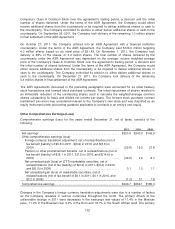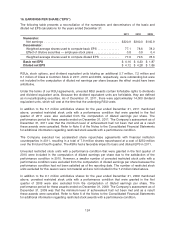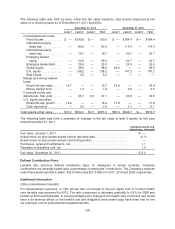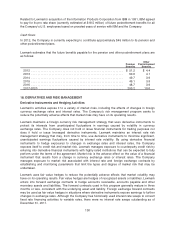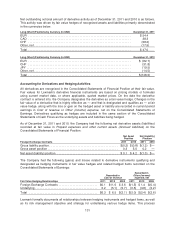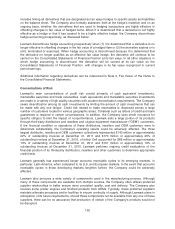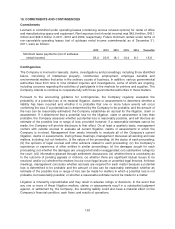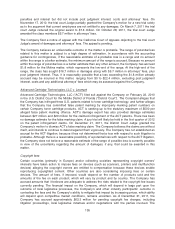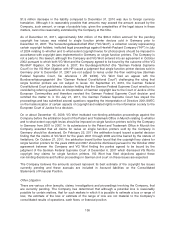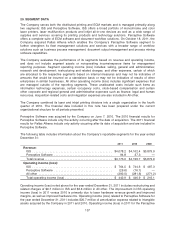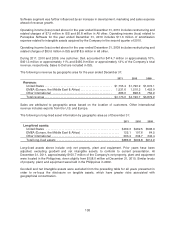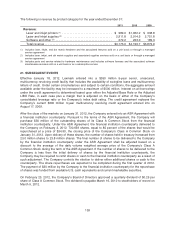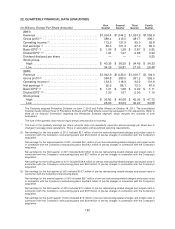Lexmark 2011 Annual Report Download - page 136
Download and view the complete annual report
Please find page 136 of the 2011 Lexmark annual report below. You can navigate through the pages in the report by either clicking on the pages listed below, or by using the keyword search tool below to find specific information within the annual report.includes linking all derivatives that are designated as fair value hedges to specific assets and liabilities
on the balance sheet. The Company also formally assesses, both at the hedge’s inception and on an
ongoing basis, whether the derivatives that are used in hedging transactions are highly effective in
offsetting changes in fair value of hedged items. When it is determined that a derivative is not highly
effective as a hedge or that it has ceased to be a highly effective hedge, the Company discontinues
hedge accounting prospectively, as discussed below.
Lexmark discontinues hedge accounting prospectively when (1) it is determined that a derivative is no
longer effective in offsetting changes in the fair value of a hedged item or (2) the derivative expires or is
sold, terminated or exercised. When hedge accounting is discontinued because it is determined that
the derivative no longer qualifies as an effective fair value hedge, the derivative will continue to be
carried on the Consolidated Statements of Financial Position at its fair value. In all other situations in
which hedge accounting is discontinued, the derivative will be carried at its fair value on the
Consolidated Statements of Financial Position, with changes in its fair value recognized in current
period earnings.
Additional information regarding derivatives can be referenced in Note 3, Fair Value, of the Notes to
the Consolidated Financial Statements.
Concentrations of Risk
Lexmark’s main concentrations of credit risk consist primarily of cash equivalent investments,
marketable securities and trade receivables. Cash equivalents and marketable securities investments
are made in a variety of high quality securities with prudent diversification requirements. The Company
seeks diversification among its cash investments by limiting the amount of cash investments that can
be made with any one obligor. Credit risk related to trade receivables is dispersed across a large
number of customers located in various geographic areas. Collateral such as letters of credit and bank
guarantees is required in certain circumstances. In addition, the Company uses credit insurance for
specific obligors to limit the impact of nonperformance. Lexmark sells a large portion of its products
through third-party distributors and resellers and original equipment manufacturer (“OEM”) customers.
If the financial condition or operations of these distributors, resellers and OEM customers were to
deteriorate substantially, the Company’s operating results could be adversely affected. The three
largest distributor, reseller and OEM customers collectively represented $140 million or approximately
22% of outstanding invoices at December 31, 2011 and $170 million or approximately 25% of
outstanding invoices at December 31, 2010, of which Dell accounted for $85 million or approximately
13% of outstanding invoices at December 31, 2011 and $107 million or approximately 16% of
outstanding invoices at December 31, 2010. Lexmark performs ongoing credit evaluations of the
financial position of its third-party distributors, resellers and other customers to determine appropriate
credit limits.
Lexmark generally has experienced longer accounts receivable cycles in its emerging markets, in
particular, Latin America, when compared to its U.S. and European markets. In the event that accounts
receivable cycles in these developing markets lengthen further, the Company could be adversely
affected.
Lexmark also procures a wide variety of components used in the manufacturing process. Although
many of these components are available from multiple sources, the Company often utilizes preferred
supplier relationships to better ensure more consistent quality, cost and delivery. The Company also
sources some printer engines and finished products from OEMs. Typically, these preferred suppliers
maintain alternate processes and/or facilities to ensure continuity of supply. Although Lexmark plans in
anticipation of its future requirements, should these components not be available from any one of these
suppliers, there can be no assurance that production of certain of the Company’s products would not
be disrupted.
132


